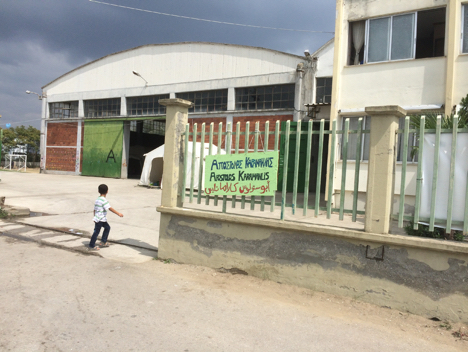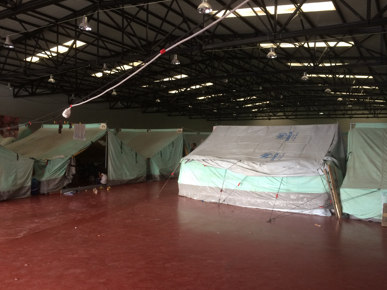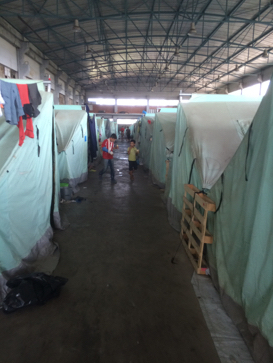February 28, 2017
My first exposure to the “refugee crisis” was in the summer of 2013, just before my senior year of high school. I was in Istanbul visiting family and the Turkish nightly news was consumed with reports of increasing numbers fleeing the seemingly endless violence in Syria. Thousands were pouring across Turkey’s borders every day, and Turkey was not prepared for the neighboring civil war to spill over. Turkey did not have stringent border control at the time, perhaps because many refugees did not intend to stay. Some planned to stay just for a few months, to gather the necessary papers and funds to make their way to Europe.
As the years progressed, the war in Syria intensified, and the numbers of people fleeing the country increased exponentially. Once considered a regional issue, the refugee crisis soon occupied the international stage. I thought about what I could do, as a college student thousands of miles away but still deeply invested in the situation. It upset me to read the news every day and be exposed to such immense suffering, then return to my comfortable, fortunate life and be unable to do anything to help what I knew others were going through. As an immigrant myself, who was able to migrate by choice under much better circumstances, I recognized how difficult and painful it must be to leave your home country in ruins and relocate to a place where you don’t know the language and are not welcomed by the local community. I could only imagine how awful it must be to be viewed as a problem, a burden, or a terrorist when you are anything but.
I wanted to do something to learn more about the refugee crisis and find out if I could help, despite my limited experience. My opportunity to get involved came coincidentally, when one of the doctors in my summer internship mentioned her experiences volunteering with the Syrian American Medical Society (SAMS). SAMS runs several clinics in refugee camps in Greece, Jordan, Lebanon, and Turkey, and she had worked for six weeks in one of the camps in northern Greece prior to our program. As she spoke of her initial desire to do something, anything, to ease the burdens facing so many, and of the work SAMS did, and I was instantly sold. I packed my bag and went to Thessaloniki the following month.

Entrance to Karamanlis
In Thessaloniki, I met the SAMS team on the ground, comprised of several doctors, nurses, and translators, all volunteers, who worked on site as long as they could take time off from their jobs back home–anywhere from two weeks to several months. There was a lot of turnover as people arrived and left, with at least a few new faces in the group every week. As a non-medical volunteer, I worked in triage, pharmacy, and as a translator for the occasional patient who spoke Turkish. The other volunteers were from all over the world, and had all come with a similar motive to mine: they simply felt they could not sit at home anymore watching this crisis take place without using their skills to contribute.
SAMS operates in three Thessaloniki camps: Karamanlis, Frakapor, and Iliades. I was first assigned to Karamanlis was the camp —comprised of three abandoned warehouses filled with rows upon rows of white tents. It is home to over eight hundred people of all ages. I came to know many of them well – from the 72-year-old grandfather of seven who came in with high blood pressure and blood sugar and gave me the biggest hug even though I hadn’t done anything for him yet, to the baby who bit my cheek while I was holding her, waiting for her parents to finish up with the doctor.

Camp Karamanlis
The camps are operated by the Greek military, and humanitarian organizations like SAMS run essential services such as the primary care clinic, women’s health care, education initiatives, mental health care, and other basic services.
The tents are set up in one of the large warehouses, and the other holds the camp’s shops, education, and extracurricular activities. Residents are not allowed to work in Greece, but some run small businesses, including a coffee shop and falafel shop. At the local “grocery store”, residents can buy essentials such as soap, shaving supplies, etc. with the points they receive on a weekly basis through the Swiss Red Cross. There is also a “school” in this warehouse, where children are taught an hour of English and an hour of Arabic by Swiss Red Cross volunteers each day. The “gym,” with a couple of weights and a yoga mat, is also in this warehouse. There’s a recreational area with a play-station that always draws a crowd, and a big open space to play soccer. Karamanlis has the most amenities of the three camps I saw. The other two camps near Thessaloniki where SAMS works did not have any amenities aside from the “school.”

Karamanlis: children play between the tents
By the time many of the refugees had arrived in Karamanlis, they had already lived for a few months in the camps in Turkey and spent the winter in Idomeni, the town at the border between Turkey and Greece where many of the refugees were processed. One patient said of Idomeni: “it rained all the time and you could never get dry or warm.” The patients had been through so much by the time they came to our clinic—it was no longer the physical signs of war that we attempted to treat, but the psychological aftermath. As a primary care clinic, we saw mainly patients with high blood pressure and diabetes there for their medications, children with fever and diarrhea, and the occasional teen with an injury from rough-housing around the warehouses.
I quickly realized that our role as volunteers was not simply to provide medical care—the physical ailments were never serious—but also to show residents in the camps that people do care about their plight, and that they have not been abandoned by the international community, despite however much they might feel that way due to the increasingly violent rhetoric against them. Our time as volunteers was a testament to the fact that so many would – and did – come from halfway across the world in the hopes of helping them, even in a small way.

SAMS clinic in camp Iliades
I spent three weeks in the camps, mainly in Karamanlis, and came to know several of the residents quite well. There were the young men in their twenties who had been forced to leave their studies at university when the war began and would help us around the clinic and work as translators for SAMS. One was halfway through his studies as a chemist when his family was uprooted. His parents were still in Syria, his brothers dispersed among Germany, UAE, and Turkey. Another was a poet, an English major whose dream was to finish his studies and write. He had been waiting for four months for his second interview with the United Nations High Commissioner for Refugees (UNHCR) to be granted permanent refugee status and sent to a country in Europe. When I asked him where he hoped to end up, he replied, “Anywhere that will take me. I will learn the language. I just want this waiting to be over.”
Then there was the little girl of eleven years who was friends with all of the medical, military, and NGO personnel in the camp. Her family invited me to their tent for coffee every day, and we would chat about their family back in Syria, and the few members who were able to relocate, and finally their hopes for their daughter. Her older brother, 21, was an engineering student in Damascus, and when we talked about life in the camps, he told me, “I used to have a full life, where I had a plan for every day and every night, now I am just waiting, for what, I don’t know.”

Conducting triage in camp Frakapor
One lady who had lived next to a hospital near Aleppo spoke of the sirens day and night and the horrors she had seen and ultimately escaped from with her five children. She showed me what someone had written, in red, on one of the canvases that made up the tents: “In Syria I expected to die at any moment, now in Greece, I am actually dying every day.” She told me that was the most accurate portrayal of how she felt. The worst was definitely over, and her family was out of the way of immediate harm, but now their future was so uncertain and the waiting had grown so long that it was difficult to remain hopeful.
Yet there were the occasional glimpses of hope that proved to me the resilience of the residents: the mother who scraped together the supplies to make her son a cake for his sixth birthday; the man who ran a falafel stand in the camp with supplies he would get from town; the music that was always blasting from one tent or another in Frakapor, accompanied by at least several people dancing to it; and the happy stories of relocation, like the man who worked as a translator with SAMS while he was in the camps and is now settled permanently in Thessaloniki. The stories of resettlement are the best ones, and they give so much hope to everyone still waiting in the camps.

The falafel stand in Karamanlis
One story in particular stands out to me, of a lady I met in the clinic. She was there because her young son was having breathing problems. The doctor prescribed an inhaler, and at the end of the visit as we were writing in the patient’s medical record book, we realized it was his birthday in one week. He would be turning six. When we mentioned this and congratulated him, his mom began tearing up. She said her son had recurrent health problems back in Syria, and they were afraid of how the move would affect him. She gave us all (me, the doctor, and the translator) kisses on the cheeks and thanked us. She said she was so thankful he had made it to this point. Despite the shortage of supplies at the camp, she and her family managed to make her son a cake that week.
Before my trip, I hadn’t anticipated the mental costs of living in the camps. Not of having experienced the war, but solely of being in a state of perpetual waiting in the camps. I had never considered the crushing boredom and uncertainty refugees experience. They’re caught in a limbo: because of border closings, they cannot move forward to Europe. Because of safety issues, they cannot go back to their homes. They are not allowed to work in Greece, so many simply sit around the camp or in their tents with nothing to do, thinking about all of the traumatic events they’ve experienced. While many are thankful to be away from the violence, the waiting itself is, as one resident explained to me, “a kind of slow death.”
It was those who managed somehow to keep a positive attitude that were visibly pillars of strength for everyone around them. It seemed that having a single positive person among twenty others was enough to get all twenty through the trying times. Rather than sit in their tents, these pillars of strength would play with the children, teach them math, run a soccer camp, help us out in the clinic, run the coffee shops. They brought life and energy to everyone around them.
I think politicians and media outlets portray refugees the way they do because they have never met them. They have not been invited into their tents and offered food and hospitality by people who barely have enough to feed themselves. They’ve never seen a mother cry tears of joy that her son has made it to age six. They’ve never seen a young chemist with so much potential teach children math and soccer, teach volunteers Arabic, and dance to Justin Timberlake’s “Can’t Stop the Feeling” in the middle of an abandoned warehouse. If they met these individuals , they would see that there is no difference. These people are not dangerous. They were just unlucky enough to be born into a time and place of conflict and stereotypes against their faith that prevent their relocation. They are humans and they deserve a chance at a peaceful, dignified life. Negative media portrayals paint a completely untrue picture of refugees and contribute to preventing their relocation. Media plays a huge role in shaping public opinion. I think that if the media portrayed refugees for who they actually are –people just like everyone else– relocation would not be as contentious an issue. If the media shed a more positive and realistic light on refugees, the “refugee crisis” would be much more easily tackled.
I’m coming to realize that one of the best ways to help would be to challenge the negative narrative surrounding refugees in our own countries. And there’s so much that we can all do to influence this perception and advocate for refugees. We can start by challenging the rhetoric used when talking about refugees among our families and friends. We can call and write to our representatives in Congress; we can donate to or work with the many NGOs and UN agencies doing such important work on the ground. The most important thing to remember is that everyone just wants to feel safe and cared for. Any small way to show the millions that have been displaced that the world has not turned its back on them and that there are many who care about their lives would make an immense difference.
Here are links to some of the many organizations involved in aid efforts on the ground:
Syrian American Medical Society
United Nations High Commissioner for Refugees (UNHCR)
International Organization for Migration (IOM)
By: Eda Algur, Harvard College ’18
SAMS Global Response Volunteer



